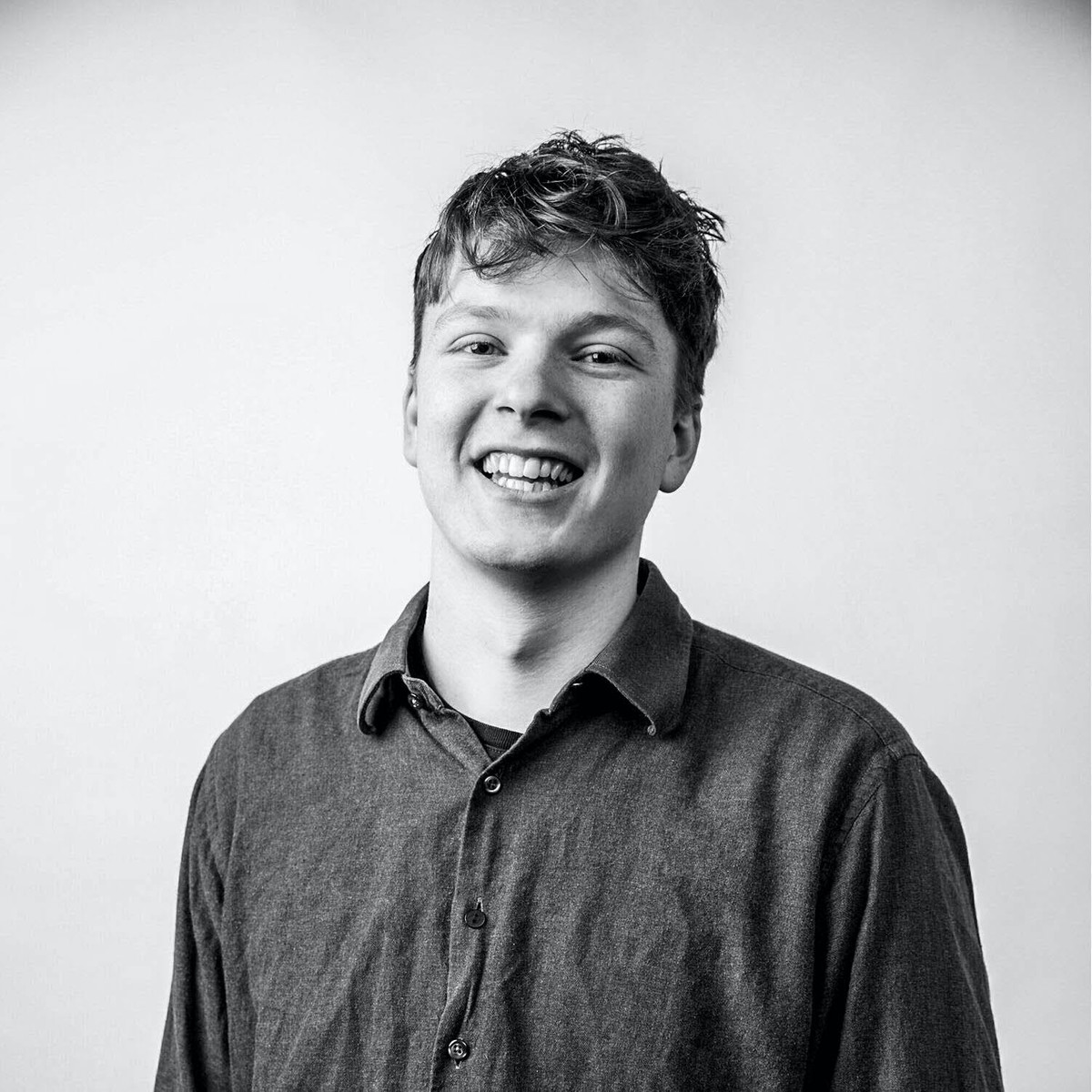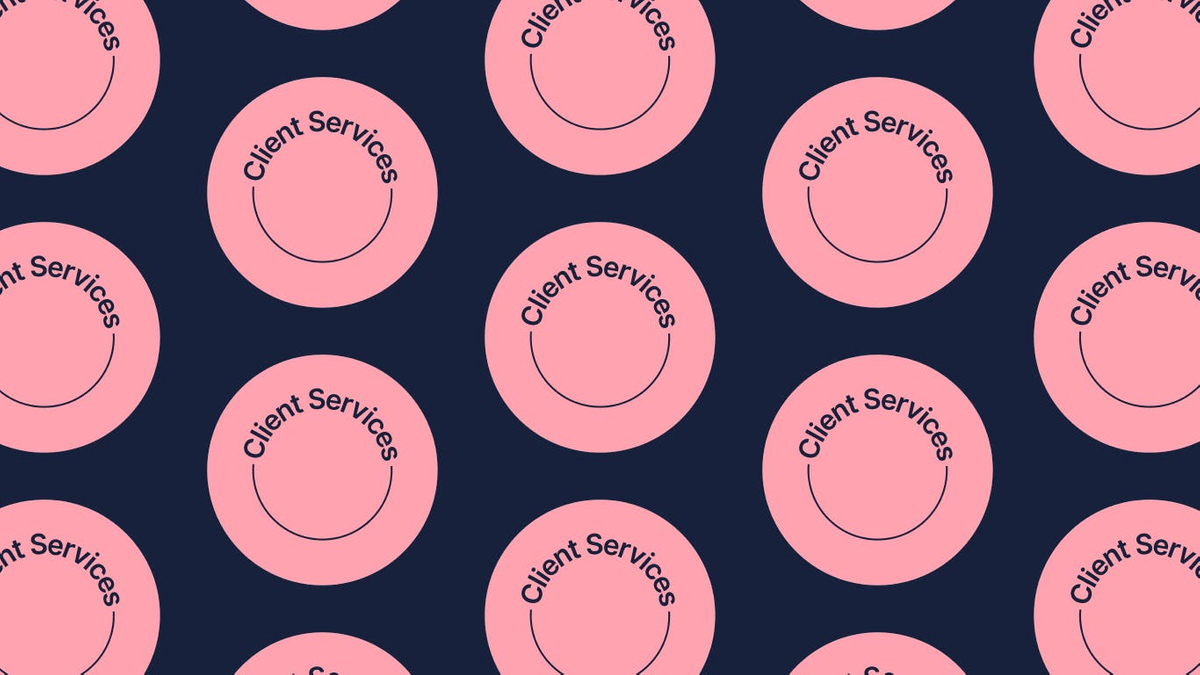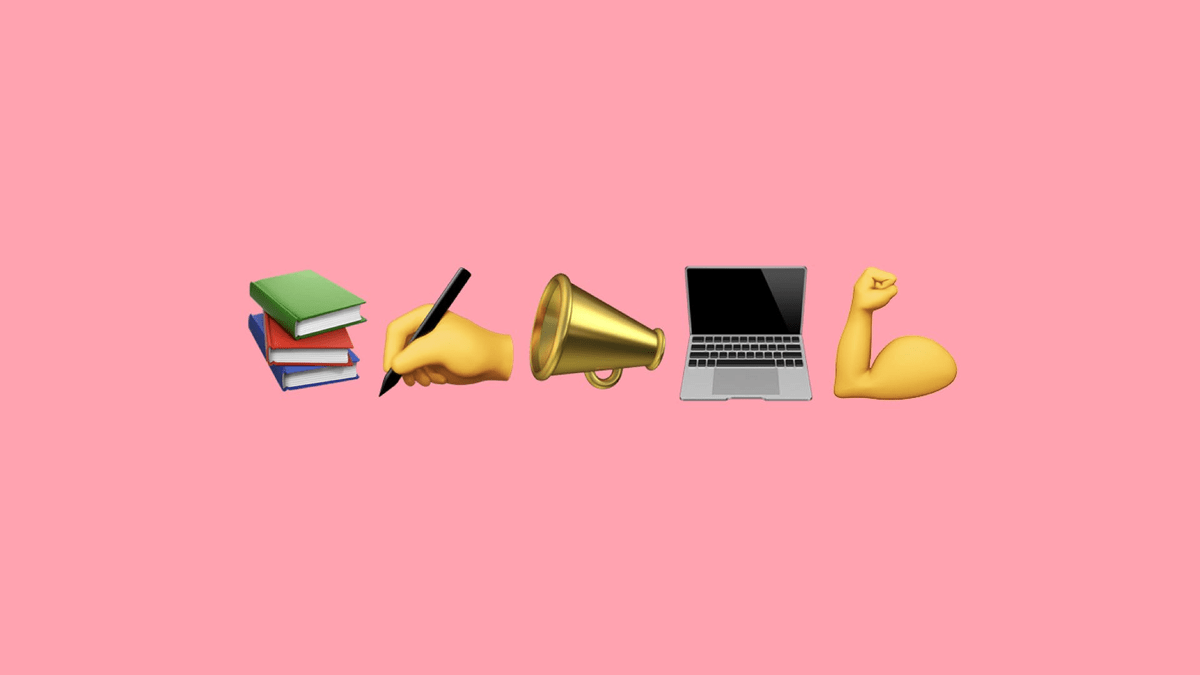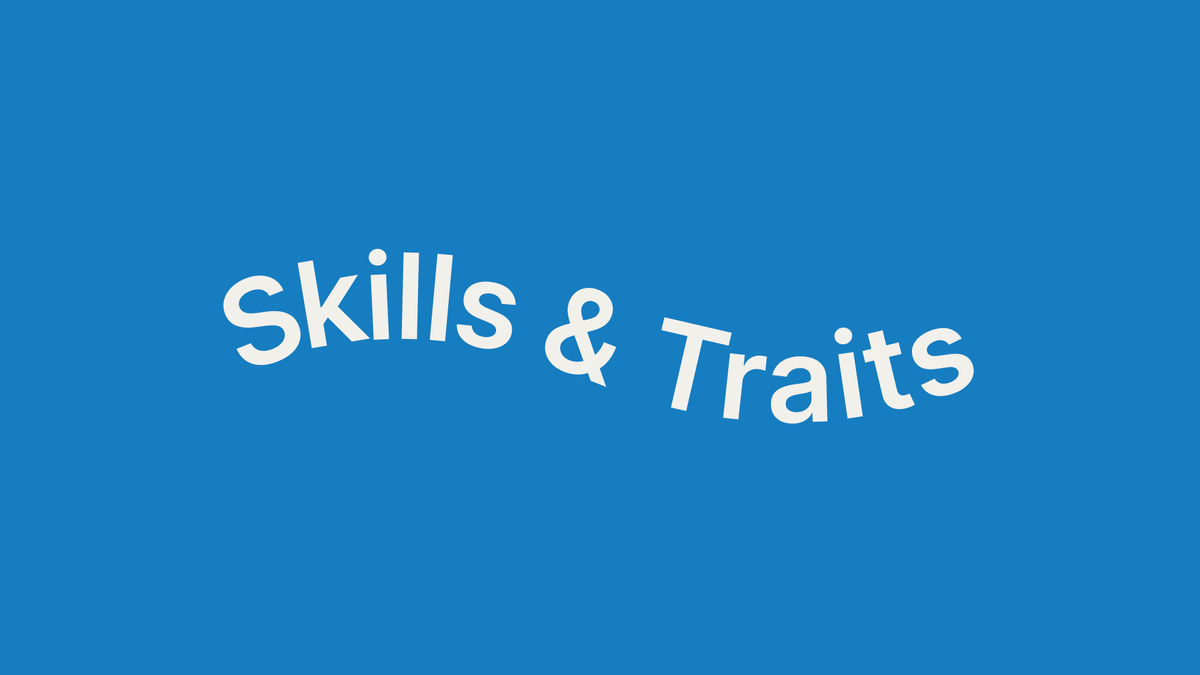How I got here
With Eden Fish, UX Designer at Sky
— February 2021
For the next in our How I Got Here series, and to follow on from our recent posts about Product Design, we caught up with London based UX Designer, Eden Fish. In this interview, he shares what he learnt on his journey from studying Graphic Design at Falmouth University to homeschooling his way into a UX role at Sky.
Who are you?
My name is Eden Fish, and I’m a UX Designer.
What do you do?
In my role, I help make products more usable, useful and enjoyable. In my team at Sky Design, this involves designing experiences and interfaces for TV – and making sure our tech works for humans.
Where are you based?
London.
Where can we find your work?
Starting out
Where did your journey in the creative industry begin?
When I first moved to London after uni, I started as a design intern at DesignStudio, where I met new pals Maddi and Amelia Leuzzi, who both helped me find my feet and get stuck in to branding projects. I really enjoyed it, and learned a lot in my 3 months there, but I was never completely convinced I wanted to be a visual designer. We had lots of helpful chats at the pub about design, strategy (which I was interested in trying at this point), and general career thoughts. From there I moved over to SomeOne, another branding agency, and got my first role working as junior designer. I spent a year and half there before I moved into UX.
What’s your education background? Did it help you get to where you are now?
After an art foundation course, I studied Graphic Design at Falmouth. Graphics is a well-trodden path into UX as it shares a lot of the same skills: visual communication, page hierarchy, layout, problem solving. If you get to spend any time at a design agency, you can pick up some of the softer skills: workshopping, pitching ideas, presenting work and taking critical feedback – all equally valuable in the world of designing products and digital experiences.
These skills can make the fundamentals of UX a lot easier, but it’s important to stress they aren’t a necessity. People often come from backgrounds like psychology, computer science, software development, product design and marketing – to name a few. On my team are an even more diverse bunch: a former Law Student, an ex-Novelist and an erstwhile Project Manager at the Royal College of Psychiatrists. In short: I think a design degree helped me on my path, but it’s by no means a prerequisite. UX is a remarkably open and welcoming community, and there are a multitude of ways to move into the field.
How did you first hear about UX and why did you think it might be right for you?
For a long time, UX had always been something in the background. I’d heard about it, confused it with UI design, and brushed it off as ‘making apps’. I never thought it was for me. However, when thinking about changing direction, I looked back at some of my previous work. In my final year at uni, I had worked on a D&AD brief for the BBC, focused on emerging technology and interfaces. My dissertation topic had been “Designing for Distraction”, examining the ethics of attention, notifications and instant gratification besetting digital products. And, while at DesignStudio, I was impressed by their approach to brand strategy: immersion with the client and their customers (e.g. becoming Deliveroo drivers for a day) to inform the design process. Reflecting on those experiences, I realised I had been interested all along – there was a human-centered theme running through all of them, which I hadn’t initially connected to a UX discipline.
For a long time, UX had always been something in the background. I’d heard about it, confused it with UI design, and brushed it off as ‘making apps’. I never thought it was for me.
UX itself emerged when researching lots of possible next steps, and as I began to read about it, and examine what I’d liked about previous work I'd done, the more it began to make sense to me. As I learnt, UX Design as a process is (in theory) a lot less subjective. You can test things, and if they work, you run with it. It’s also iterative. You don’t have to conjure a brilliant concept from thin air. You start with lots of okay ideas – often based on real data and insight, and constantly test/improve. I thought this was great, because I was (on the whole) below-average at coming up with brilliant ideas on-the-spot, and usually the more pressure I put on myself to be creative, the less creative I felt.
You gave yourself a 6 month crash course in UX, what did that entail?
I started off by reading a few UX books, which helped me figure out if this was definitely the thing I wanted to pursue. Once I was set on it, I began signing up for events and talks, where I could start learning a few things, and meeting people.
I messaged friends, previous colleagues, looking to find anyone that worked in the industry, or in related roles. I’d ask to go for a chat over a pint, (sometimes coffee, usually pints), and began to try to build up a picture of the best way I could move across. I was lucky enough to find Steph, a UX and Service Design Consultant, through my old university tutor, who became a fantastic Whatsapp (and occasionally real-life (pre-pandemic)) mentor.
I also began to do a few Linkedin Learning courses, and started reformatting my old Graphic Design portfolio to spin older projects towards UX – adding new bits, reformatting, rephrasing. I’d occasionally check-in with people that I'd met at talks, and ask for a bit of portfolio guidance. I began looking to do a side-project that I could show at interviews, but I’ll confess that I actually never finished this before I went for my Sky interview.
I think my focus was to try and get to a bare minimum and understand what recruiters might be looking for. I knew that if I could secure any kind of UX-related role, I could learn on the job.
How did that help you bag your first role in UX?
I think my focus was to try and get to a bare minimum and understand what recruiters might be looking for. I knew that if I could secure any kind of UX-related role, I could learn on the job. I didn’t have a vast portfolio of wireframes, personas or user-testing, but I had a couple of projects that were loosely related, and I could demonstrate that I knew (from books and resources) what UX was. My pitch at this point was I think i’d be good at this, but I haven’t done it yet...
Once I’d met Steph, she began to steer my learning and helped me focus my energy on the right things. When it came up, she also gave me some great tips for the Sky interview. If you can find a Steph, things will definitely get a little easier. But you can’t have actual Steph, she’s mine.
When I applied at Sky, they had a design challenge stage in their interviews: a small brief to complete. Companies are increasingly building these into their recruitment process – for better or worse. In my case it gave me my first real attempt to demonstrate what I’d learned over the last 6 months or so, and put the theory to practice.
My role
So, what do you actually do everyday?
Day-to-day, it depends on the project, stage, and what I’m needed for.
At the start of a project, it could be research into competitor products, gathering previous projects and data from within Sky, or running workshops with other designers and stakeholders to define the problem and the future of the project. We might also want to do some generative research (early discovery, usually informal interviews) with customers at this stage to get early user insight, to again shape our understanding of the problem or feature, and also help designers and product owners empathise with customers as they begin to design and prioritise work.
If I’m then beginning to work on a project, I might be gathering thoughts and ideas in a Miro board, doing sketches (on paper, Invision), wireframes (XD, Figma) - or if they need to be interactive, prototypes at different fidelities (XD, ProtoPie).
If it’s later in the project, I might be working alongside a UI Designer to agree on a direction for how it looks and animates, or creating specs for the development team, so we’re aligned on what to build. I’ll also check in often with Product Leads (who ‘own’ features, like ‘Voice Search’), to figure out what’s possible from a capability perspective.
If we want to see if a design solution works, we’ll set up a prototype for testing, usually alongside our UX Research team (who facilitate and moderate UX research with real users, analyse data, video and interviews, and produce research findings and recommendations – among a plethora of other brilliant things). On my side, this can involve prepping the prototype, setting goals and assumptions for the testing, watching the tests run, and helping to review and analyse them - so we know how to improve what we’ve designed.
How would you describe the role of UX to a stranger down the pub?
You know when you hate using something? My job is to make that not happen.
I’m writing this in lockdown 3.0, so have forgotten what pubs are like. Are they nice? I can’t remember.
It usually goes something like: “You know when you hate using something? My job is to make that not happen.”
UX and UI often come together under one role, why is your role solely UX focused?
When I joined Sky, my wider team had just finished undergoing a bit of structural shift, and my colleagues had recently shed their Product Design titles, (focusing on both UX and UI) and been split into two teams, (unsurprisingly, UX Design and UI Design) – each focused on their discipline, but with the freedom to input and collaborate on work. It’s a growing team, so it makes a lot of sense to make the roles more specialist. This was perfect for me, as UX was the reason I’d moved over, and those responsibilities were what I had prepared for.
As well as UI designers, I also work alongside UX Researchers, UX Copywriters and Product Leads – but at a smaller company or startup, you’re likely to find some/all of these rolled into one job title (often titled UX/UI or Product Designer). Check out Meaghan’s brilliant article on this for a deeper dive. So to clarify, I don’t focus on any of the UI, the design system, colours, typography etc, but I have a say, especially if it affects UX principles like usability or accessibility.
In short, why do you like UX?
- I love that the core responsibility of this role is to always advocate for the users, and their needs.
- I absolutely love tech and it no longer needs to be a side-interest.
- I get to work amongst a broad variety of other roles, not just designers.
How has the current climate affected how you work?
I started this role 3 months after lockdown, so was onboarded, met colleagues and began working completely remotely, which was a pretty unique experience. Like everyone, I think I’ve found pros and cons to the WFH life. Lunch is cheaper but my bedroom is lonely. Presenting work is a lot more relaxing, but I do miss casual conversations and coffee breaks... and so on.
In our team, the shift to online collaboration spaces like Miro and Figma has been swift, and like many others, we use a raft of digital tools to work and communicate. All our design Away-Days, Meet-ups and Conferences are now hosted virtually, which poses challenges and opportunities. We can now have 70 people in a talk, where a room could only fit 30 - but how do we keep everyone feeling engaged and sociable? We have to be more thoughtful about our overall design process, especially as we transition to hybrid working - and look to communicate in newer, healthier ways – to keep tabs on projects that are constantly changing, without getting distracted or spending 8 hours a day in meetings.
I started this role 3 months after lockdown, so was onboarded, met colleagues and began working completely remotely, which was a pretty unique experience.
What’s next for you?
I want to make sure I can soak up as much experience and knowledge from my colleagues as I progress in this role. I’m continuing to chow down on design books, heading to talks and conferences, and making sure to book in training when I can. I’m still at a bit of a ‘learn on the job’ stage, so I’m keen to get to a point where I can run multiple full projects and facilitate workshops and design sprints on my own. I’m also beginning to get involved with support and mentoring, where I’m keen to to help those interested in starting a career in UX.
The future
I’m a graduate who’s interested in UX design, where do I start?
I think the answer to this is dependent on how much you already know about UX. I knew virtually nothing - so, as a baseline, if you’re starting from zero:
- Make sure this is something you’re keen to pursue. Read up a little about UX. If you’re used to Visual or Graphic Design, the day-to-day can be pretty different and much more varied: there’s a chance you might be writing interviews, analysing datasets, or handing-off to developers, so make sure you’re (at the very least) interested in doing some of that. Also, make sure to check out similar paths like Service Design, Customer Experience, Interaction Design and UX Research at this stage. Consider your own skill set, and which bits of UX you’re interested in. If you like Digital Design and UI, you might want to aim for a UX/UI (sometimes Product Design) role, where you’re more likely to focus on a mix of both disciplines.
- Try and contact as many people you can that work in the UX community - friends of friends, or a loose connection on Linkedin you deduce from their profile to be reasonably friendly. If they’re up for a chat, they’ll have plenty of different ideas, suggestions and knowledge. Use this to build an understanding, and to help you make a plan...
- Make a plan! Set rough goals you’ll work towards. Chat to 5 UX designers. Get two projects in your portfolio by next September. Apply for a bootcamp. Whatever stage you’re at, and whatever you’d like to achieve, work to figure out what’s right for you – and the people you meet along the way can course-correct you towards a realistic goal.
- Consider doing a side-project. Once you’ve read as much as you can, and feel you have a solid understanding of UX, design thinking, and what companies might be looking for, ask someone to set you a brief – or set one for yourself – or work on one with a friend. The trickiest thing here is to get the balance of effort right. Something that’ll take you between 2 weeks to 2 months. And make sure you take pictures of everything along the way.
What advice would you want to share with someone embarking on their UX journey?
- There’s an overwhelming amount of resources out there - blogs, books, podcasts, talks. Don’t feel the need to engage with all of them. Don’t stress, pick a few good ones at a time, and roll with it.
- Your portfolio doesn’t have to be perfect, and for ‘pure’ UX roles, won’t need to be beautiful either. (In fact, ugly is sometimes better). They need to be coherent, tell a story from start to finish, and you need an answer for why you’ve made each decision - which you’ll always want to base around your project’s users.
- Unless it's a specialist role - you won’t really need to know anything about development or coding. It can help, but that won’t affect your core role a whole lot. It’s probably more worth your while learning a tool like ProtoPie instead.
- Different companies use different tools for wireframing and prototyping. They are easy to learn and switch between, so pick one or two and stick with them. Companies aren’t expecting you to be exactly aligned to their workflow. For example, start with Invision Freehand for simpler sketches and Figma for wireframes and prototyping.
- If you’re thinking about doing a side-project, I’d suggest leaning away from ‘redesigning an app’ that already exists. Try to focus on a small problem or challenge – and build something to solve it. If you can’t do any of your own user-testing, lay out what you would do if you had the resources, time etc.
What is the one thing you wish you had known before starting out in UX design?
If you search job sites for UX designer, you’ll notice every job description is different… This often emerges when companies and recruitment companies either don’t understand the role properly, or they’re a smaller company looking for someone who just ‘does a bit of everything’.
So. One quick thought: If you search job sites for ‘UX Designer’, you’ll notice every job description is different. This confused me, and put me off slightly when I started looking. Front end development experience? Portfolio of stunning and incomparable UI Design? I swear this isn’t what a UX Designer does...? This often emerges when companies and recruitment companies either don’t understand the role properly, or they’re a smaller company looking for someone who just ‘does a bit of everything’.
If you’re looking for a pure UX role (or at least, one that fits the description that initially interested you), read these carefully. If you like UX, UI and sometimes Interaction or Animation – those hybrid roles may be a better fit for you. I was personally keen to move away from Visual Design, and focus specifically on UX - which Sky’s structure supports.
You may see a variety of other UX-related role titles, including Product Designer. While there are loose definitions, there’s no exact standard for what this means (and role names change all the time), so instead of the title look at the responsibilities, and decide if they support the direction, and day-to-day work you’re keen to pursue.
What would you like to see change for young people starting out in the industry?
It’s an awfully tricky time in the jobs market, but this is as true before coronavirus as it after; I’d like to see a lot more internships, traineeships, graduate schemes and entry level opportunities, as there often are in Graphic Design. There are very few roles, if any, advertised as Junior UX, Graduate UX or UX Design Intern. It would be great to see companies taking risks, investing more in the future of this role, and offering pathways for graduates to learn and work at the same time.
Companies don’t always seem to know how to advertise roles properly (e.g. UX/UI), which can lead to a lot of confusion and gives the impression they don’t really understand the value and importance of implementing proper user-centred design at the core of their business. I’m optimistic this will change as UX continues to grow, but we’re still not there yet – and it can present a bewildering, opaque landscape for graduates.
I’d also love to see Universities promote this branch of design internally, especially on Graphic Design courses. I think I would’ve liked at least one external speaker, one workshop, or lecture - because I’m pretty confident if I had known more then, I would’ve started my journey a lot earlier.
Words by Eden Fish. You can find him on Linkedin.
Coming soon: Eden shares some of the resources he found useful on his journey into UX design 👀
See our latest posts



